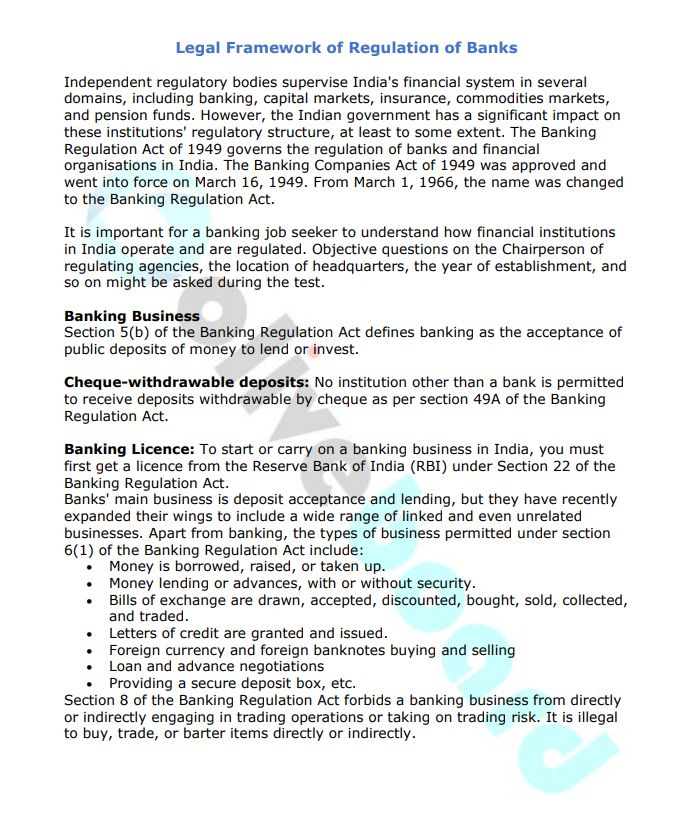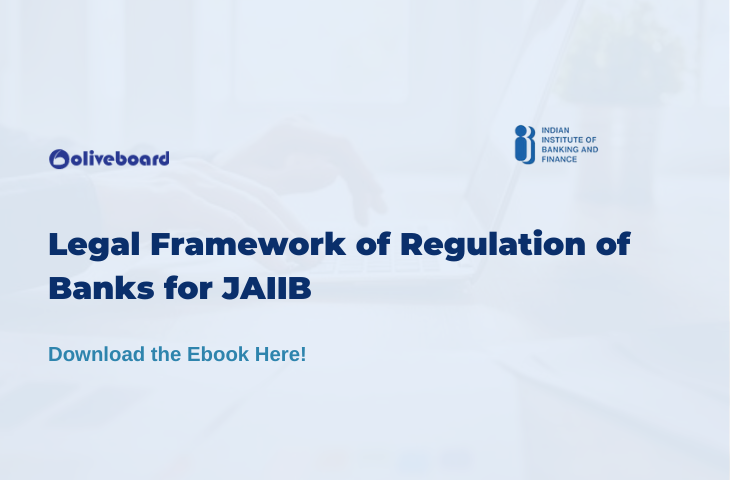Independent regulatory bodies supervise India’s financial system in several domains, including banking, capital markets, insurance, commodities markets, and pension funds. However, the Indian government has a significant impact on these institutions’ regulatory structure, at least to some extent. The Banking Regulation Act of 1949 governs the regulation of banks and financial organizations in India.
It is important for a banking job seeker to understand how financial institutions in India operate and are regulated. Objective questions on the Chairperson of regulating agencies, the location of headquarters, the year of establishment, and so on might be asked during the test. In Legal Framework of Regulation of Banks E-book you will learn about them. Download the free e-book now.
Banking Business
Section 5(b) of the Banking Regulation Act defines banking as the acceptance of public deposits of money to lend or invest.
Cheque-withdrawable deposits: No institution other than a bank is permitted to receive deposits withdrawable by cheque as per section 49A of the Banking Regulation Act.
Banking Licence: To start or carry on a banking business in India, you must first get a licence from the Reserve Bank of India (RBI) under Section 22 of the Banking Regulation Act.
Banks’ main business is deposit acceptance and lending, but they have recently expanded their wings to include a wide range of linked and even unrelated businesses. Apart from banking, the types of business permitted under section 6(1) of the Banking Regulation Act include:
- Money is borrowed, raised, or taken up.
- Money lending or advances, with or without security.
- Bills of exchange are drawn, accepted, discounted, bought, sold, collected, and traded.
- Letters of credit are granted and issued.
- Foreign currency and foreign banknotes buying and selling
- Loan and advance negotiations
- Providing a secure deposit box, etc.
Section 8 of the Banking Regulation Act forbids a banking business from directly or indirectly engaging in trading operations or taking on trading risk. It is illegal to buy, trade, or barter items directly or indirectly.
Constitution of Banks
In India, banks are classified into one of the following categories:
- A legal entity formed under certain legislation;
- Foreign company/company registered under the Companies Act of 1956
- Cooperative Society registered under federal and state cooperative society legislation.
Public sector bank
A public sector bank is one in which the Indian government owns the majority of the shares. These banks are governed by a specific statute. The State Bank of India was established in 1955 by the State Bank of India Act. The State Bank of India (Subsidiary Banks) Act, 1959 established the six State Bank of India subsidiaries. On July 19, 1969, the government passed the Banking Companies (Acquisition and Transfer of Undertakings) Ordinance, which nationalised 14 commercial banks. On April 15, 1980, it nationalised six additional commercial banks under the Banking Companies (Acquisition and Transfer of Undertakings) Act. The State Banks (Repeal and Amendment) Bill 2017 consolidates SBI’s five affiliate banks and Bharatiya Mahila Bank.
Banking Companies
A banking firm does banking business, as defined by section 5(c) of the Banking Regulation Act. Such a business might be formed under section 3 of the Companies Act, 1956, incorporated under the Companies Act, 2013, or a foreign company as defined in section 591 (u/s 379 of the Companies Act, 2013). All private sector banks are financial institutions. In terms of their formation, these banks are controlled by the Companies Act, 1956 of the Companies Act 2013, as well as the Banking Regulation Act.
Co-operative bank
In essence, a cooperative bank is a cooperative society. Multi-state cooperative societies and State cooperative societies are the two forms of cooperative banks. The cooperative society legislation of the Centre regulates multi-state cooperative societies. The state cooperative act regulates state cooperative societies. Certain sections of the Banking Regulation Act and the Reserve Bank of India Act were extended to the cooperative banking sector by the Banking Laws (Application to Co-operative Societies) Act, 1956. State/Central/Primary co-operative societies engaged in banking operations with capital and reserves of not less than one lakh are covered under the BR Act 1949. Primary agricultural credit societies and cooperative land mortgage banks are exempt.
Scheduled bank
Scheduled banks are those listed in the RBI Act 1934’s second schedule and have reserves and paid-up capital of at least Rs. 5 lakh.
Reserve Bank of India Act 1934
The RBI was founded on April 1, 1935, under the RBI Act 1934. It was originally privately held, but it was nationalised in 1949 and is currently wholly owned by the Indian government. The Reserve Bank of India Function 1934 is a law that establishes the Reserve Bank of India (RBI) and gives it several authorities to act as the country’s central bank. The company’s paid-up capital is Rs. 5 crores.
The main functions of RBI are:
- Regulates financial and monetary policy of India.
- Maintain foreign currency market in India.
- Issue currency notes and coins.
- Bankers to bankers and government.
The RBI Act of 1934 is divided into 61 sections.
Take a peek at Legal Framework of Regulation of Banks E-book

Download Legal Framework of Regulation of Banks E-Book
Download Legal Framework of Regulation of Banks free e-book
How to Download Legal Framework of Regulation of Banks E-book for JAIIB?
Step 1: Click on the download link. You will be redirected to Oliveboard’s FREE E-Books Page.

Step 2: Create a free Oliveboard account or login using your existing Oliveboard account details
Step 3: Download the book by clicking on the link presented on the page.
FAQs

Hello there! I’m a dedicated Government Job aspirant turned passionate writer & content marketer. My blogs are a one-stop destination for accurate and comprehensive information on exams like Regulatory Bodies, Banking, SSC, State PSCs, and more. I’m on a mission to provide you with all the details you need, conveniently in one place. When I’m not writing and marketing, you’ll find me happily experimenting in the kitchen, cooking up delightful treats. Join me on this journey of knowledge and flavors!
